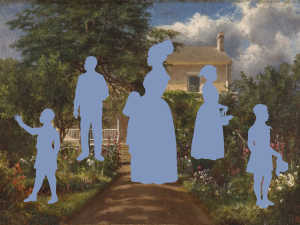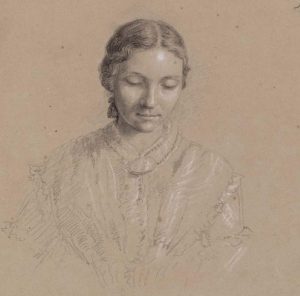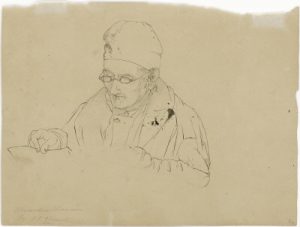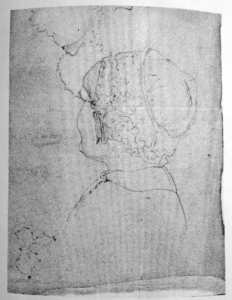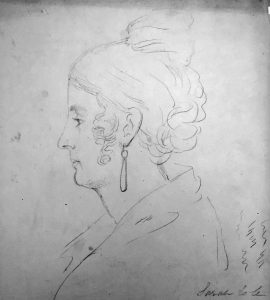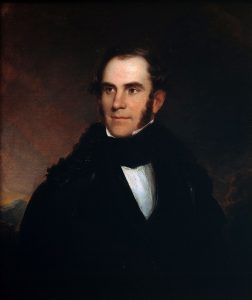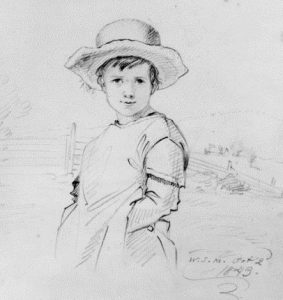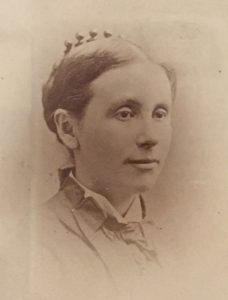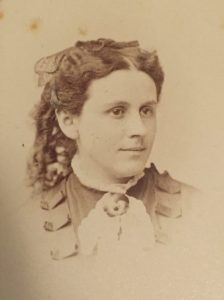Historic Household
W/Hole History: An initiative to present a more full and honest history.
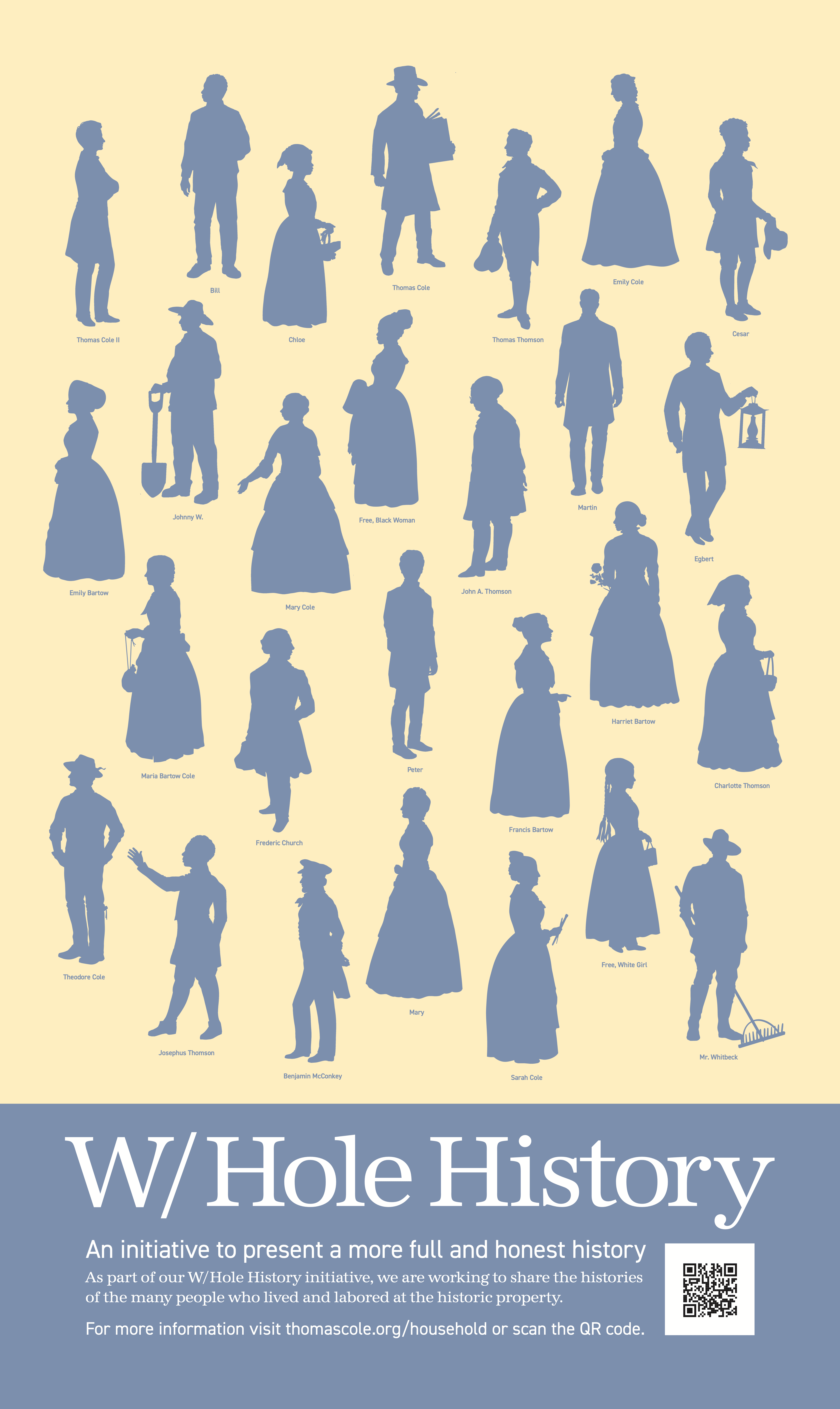
The house is not half large enough for us all.
Maria Cole to Thomas Cole, 1842
The following is an account of the historic individuals known to have lived, labored, and contributed to the historic property starting in 1790 and continuing throughout the 19th century. Thomas Cole lived here from 1836-1848, alongside 10 other people, according to the 1840 Federal Census.
Click the arrow to the right of each person to discover their history. The histories of these individuals shed light on the topics of slavery, mental health, women’s rights, immigration, and more.
Period(s) of residency, as currently known, either through a census record, letters, or oral history.
Enslaved by the Thomson family: c. 1790-1820
Abigail, Bill, Chloe, Cesar, and Josephus Thomson, were 5 people enslaved by the Thomson Family into whom Thomas Cole married in 1836. While Chloe, Cesar, and Josephus eventually received their manumissions from the Thomsons by 1820, a process that legally emancipated them, their lives are still in memory here at the historic property. There would be a continued history of labor and indentured servitude that would continue into Thomas Cole’s residency.
Learn more about the property’s history of enslavement here.
Lived at Cedar Grove: 1821–1884
Maria Bartow (1813-1884) was a niece of Uncle Sandy, and a daughter of Maria Thomson and Steven Bartow. Her sisters were Emily, Harriet, and Frances Bartow. She married Thomas Cole in 1836.
Find more about her here.
Further Reading:
Thomas Cole, Portrait of the Artist’s Wife (detail), 1836-48, Graphite with white watercolor on light brown paper, 12 1/2 x 9 5/16 in. Museum of Fine Arts, Boston, Gift of Maxim Karolik for the M. and M. Karolik Collection of American Watercolors and Drawings, 1800-1875, 55.716.
Lived at Cedar Grove: 1815–1846
John Alexander “Uncle Sandy” Thomson (1776-1846) was the head of household at Cedar Grove c. 1821-1846. With his brother Thomas Thomson (d. circa 1821), and sister Catherine Thomson (d. circa 1826), he instigated building of the Main House in 1815.
The Federal-style Main House that remains today was built by a group of people that likely included enslaved laborers. The Thomsons enslaved people from at least 1790 until 1820. Many of the original documents we’re finding around enslavement bear the signature of John A. Thomson. These legal documents serve as evidence that the family set them free according to the terms of Gradual Emancipation – a federal act that slowly abolished slavery over many years, rather than immediately. These sheets of paper may be the only surviving evidence of the lives that this family enslaved.
Find out more here.
Frederic Church, Alexander Thomson, 1846. Pencil and ink on paper, 7 x 9 5/16 in, National Portrait Gallery, Smithsonian Institution.
Lived at Cedar Grove: 1821–1881
Emily Bartow (1804-1881) was a niece of John A. Thomson, and a daughter of Maria Thomson and Steven Bartow. Her sisters were Harriet, Maria, and Frances Bartow. When her uncle, John, passed away in 1846, ownership of the property passed to Emily. As a woman, she was only able to own property because she was not married.
Emily Bartow’s signature.
Lived at Cedar Grove: 1821–1894
Frances Bartow (1815-1894) was a niece of Uncle Sandy, and was a daughter of Maria Thomson and Steven Bartow; her sisters were Emily, Harriet, and Maria Bartow. Frances’ story intersects with pivotal moments in the history of mental health. She was documented as “insane” on the 1870 census, during the time when federal censuses accounted for people with mental, intellectual, and physical disabilities from 1840 to 1890. Between 1846-1848, Frances received treatment at the Hartford Retreat for the Insane, an early example of “moral treatment” in the United States during the first generation of asylums in the country. No personal records of hers have yet been found.
Further Reading
Regarding Frances Bartow by 2021 Cole Fellow Adaeze Dikko
Understanding Frances Bartow’s Stay at the Hartford Retreat for the Insane, 1846-1848 by 2022 Cole Fellow Beth Wynne
Frances Bartow’s signature.
Lived at Cedar Grove: 1821–1904
Harriet Bartow (1808-1904) was a niece of Uncle Sandy, and a daughter of Maria Thomson and Steven Bartow. Her sisters were Emily, Maria, and Frances Bartow. Harriet was a teacher, and the flower garden outside the Main House was generally referred to as hers in letters.
Further Reading
Harriet was the recipient this unsigned Valentine in c. 1835/36.
Frederic Church, Harriet Bartow (?), c. 1844-5. Graphite on Paper, Olana State Historic Site.
Lived at Cedar Grove: 1817–late 1840s
Daughter of James Thomson and niece of John A. and Thomas Thomson.
Lived at Cedar Grove: 1840
An unnamed, free, Black woman was listed on the 1840 census as living here at the property as a laborer. Based on her age range and New York State laws, she was very likely born as an enslaved person between 1741 and 1785 (slavery was legal in New York State until 1827). She was likely a live-in laborer at the property, as the census accounts for people where they lay their head. She may have labored in cooking, cleaning, laundering, or caring for the children, dairying, and/or other essential work.
Find more about her here.
Further Reading
Regarding the Free, Black woman documented as a Cedar Grove resident, 1840 Census by 2021 Cole Fellow Adaeze Dikko
Contextual Research on the Unnamed, Free, Black Woman and Other Laborers at Cedar Grove by 2022 Cole Fellow Beth Wynne
1840 federal census (edited to show the Thomson-Bartow-Cole household)
Lived at Cedar Grove: 1847–1857
Sarah Cole (1805-1857) was an accomplished American artist known for her paintings and etchings. Like her brother Thomas, Sarah worked in the earliest years of the Hudson River School of American landscape painting art movement. She hiked and sketched with Thomas and studied with the artist Asher B. Durand. She exhibited and sold her paintings at the National Academy of Design, American Art-Union, Western Art Union in Cincinnati, and the Maryland Historical Society in Baltimore. Her work was featured in the 19th-century publications, “Women Artists in all Ages and Countries,” 1859, and “Women Etchers of America,” 1888, where she was described as the first woman etcher in the United States. She lived periodically at the property known today as the Thomas Cole National Historic Site.
Further Reading
Read an 1836 account of what it was like to travel to and from the historic property in Sarah’s own words.
Thomas Cole, Sketch of Sarah Cole (detail), c. 1840. Albany Institute of History and Art.
Lived at Cedar Grove: 1836–1848
Thomas Cole (1801-1848) began coming to the Catskills in 1825. He and Maria Bartow were married in 1836, after which he moved in with Maria and her family. Read his full bio.
Dive into his paintings with Explore Thomas Cole.
Learn more about his time here in the Catskills and on this property with Immersive Experiences.
Explore the places Thomas Cole and other Hudson River school painters hiked and painted, with the Hudson River School Art Trail.
Further Reading
Thoughts & Occurrences: The Journal of Thomas Cole
Essay on American Scenery by Thomas Cole
Lecture on Art by Thomas Cole
Asher B. Durand, Portrait of Thomas Cole, 1837, oil on canvas, 30 1/4 x 25 in. Berkshire Museum, Pittsfield, MA, Gift of Zenas Crane, 1917.
Lived at Cedar Grove: 1841-42
Germaine Mary as the Children call her is with us this winter & adds a good deal to Theddys enjoyment.
Maria Cole to Thomas Cole, Catskill, 27 Dec 1841; Cole Papers, New York State Library
I read The [illegible] letter first to Mary as she was seated by the side of Germain Mary. She was quite in extacy and every word that she understood she repeated to Mary after me.
Maria Cole and Sarah Cole to Thomas Cole, April 18 and 20, 1842; Cole Papers, New York State Library, Box 4, Folder 2
Possibly Lived at Cedar Grove: 1842
Jonny W. is his only companion. I endeavor to keep them apart as much as possible but I cannot entirely. I think his manners will suffer more than his morals for I do not think Jonny a very bad disposition.
Letter from Maria Cole to Thomas Cole in Rome, April 18, 1842. Thomas Cole Papers, New York State Library, Box 4, Folder 4
Lived at Cedar Grove: 1841-42
Today I made a call at the Griffins with Unc Sandy & theddy Egbert was our driver & the roads bad enough to keep our horses upon a walk the whole way.
Maria Bartow Cole, Journal entry from March 1, 1842. Albany Institute of History and Art, Box 1, Folder 13
I was busily occupied this morning in aranging my room and talking earnestly to the Girls of the affairs of the day, when the door was opened by Egbert with your letter in his hand.
Maria Bartow Cole to Thomas Cole, April 18, 1842. Thomas Cole Papers, New York State Library, Box 4, Folder 4
You may imagine Theddy marching about with his cap & Green coat on in a pair of Boots, (which defys all weather except zero) that Unc. S. [John A. Thomson] purchased for him a few weeks ago, I never saw him so perfectly delighted as he was when he saw Egbert take them out of the sleigh, he directly said “you must write to my Papa about my Boots.”
Maria Bartow Cole to Thomas Cole, December 23, 1841. Thomas Cole Papers, New York State Library
I take this first opportunity to tell you of my most acceptable Christmas presant, your letter Dearry. After Church on Christmas I found my self on the way to the Po. Office. I scarcely knew for what I was going, for Egbert goes regularly every day.
Maria Bartow Cole to Thomas Cole, December 27, 1841. Thomas Cole Papers, New York State Library.
Lived at Cedar Grove: 1844
The Major was here yesterday & Whitbeck was setled with. to the satisfaction of both parties I believe at least there was no difficulty. Un S. [John A. Thomson] will resume the Farm in the Spring & W. will leave. I hope that Un S. will find a man to suit him. before Spring.
Maria Bartow Cole to Thomas Cole, Jan 6, 1844. Thomas Cole Papers, New York State Library
You told me in a previous letter that Mr. Witbeck will leave this spring – has your uncle got another Farmer I am anxious to hear.
Thomas Cole to Maria Bartow Cole, February 12, 1844. Thomas Cole Papers, New York State Library, Box 3, Folder 4.
Lived at Cedar Grove: 1842
From Denmark; mentioned in as “one of our household.”
[…] by the by I must introduce you to Peter, as he is one of our household. He is a very civil Dane, was very destitute & could get no work, so Unc S. [John A. Thomson] took him in.
Maria Bartow Cole to Thomas Cole, February 10, 1842, New York State Library, Thomas Cole Papers, Box 4, Folder 2.
Occasional long-term visitor to Cedar Grove: 1835-36, probably as early as 1820
Son of James Thomson and brother of Charlotte Thomson. He witnessed Thomas Cole and Maria Bartow’s wedding on November 22, 1836
Lived at Cedar Grove: late 1840s
Described by Louis Legrand Noble as “his [Cole’s] man Martin.”
Lived at Cedar Grove: 1839–1894
Mary Cole (1839-1894) was the daughter of Thomas Cole and Maria Bartow.
Mary has been running about to day with a slip of Paper in her hand, begging for a Pencil to write to Papa. She woke one morning when it was yet quite dark, talking about Papa, wanting to go to him. She asked me if Papa had come home, I asked her why she thought so, she said “I did see Papa” I then said where, she answered “in the room sitting in the rocking chair.” She had evidently had a very vivid dream about you. She persisted in saying that she has seen you.
Maria Bartow Cole to Thomas Cole, December 23, 1841. New York State Library, Thomas Cole Papers, Box 4, Folder 2.
Brandow & Jenne, Mary Cole (detail), unknown date. Carte de visite photograph, Thomas Cole National Historic Site.
Lived at Cedar Grove: 1843–1913
Emily Cole (1843-1913) was a professional artist and the daughter of Thomas Cole and Maria Bartow. She used Thomas Cole’s New Studio as her studio and exhibition space, and was well known for her paintings of flora on paper and porcelain. Most of her painted blooms were flowers local to Catskill, ones she could observe firsthand, from spring through fall, by simply stepping outside her front door. Referred to as “Catskill China Painter,” Emily Cole connected with collectors and patrons in the Hudson Valley, Brooklyn, and beyond, who purchased her work, and she even served as a charter member of the New York Society of Ceramic Arts, founded in 1892 with the objective to promote the appreciation of ceramic arts.
Find more about her here.
Further Reading
The Art of Emily Cole (2024)
Emily is the focus of the 2025 exhibition Emily Cole: Ceramics, Flora, & Contemporary Responses, curated by Kate Menconeri and Amanda Malmstrom.
Emily was the focus of the 2019 exhibition The Art of Emily Cole, curated by Amanda Malmstrom.
Unknown photographer, Emily Cole (detail), unknown date. Carte de visite photograph in album, Thomas Cole National Historic Site.
Lived at Cedar Grove: 1847 (2 days)
Elizabeth Cole (1847) was the daughter of Thomas Cole and Maria Bartow; she lived only 2 days.
Lived at Cedar Grove: 1848–before 1875
Thomas Cole II (1848-1919) was the son of Thomas Cole and Maria Bartow.
Lived at Cedar Grove: 1844–1846 (presumably)
Frederic Church (1826-1900) was Thomas Cole’s student from 1844-1846, during which time Church presumably lived in a building owned by the Thomsons. Church later was responsible for the building of Olana, his home directly across the Hudson River from Cedar Grove.
Lived at Cedar Grove: 1845–1847
Benjamin McConkey was Thomas Cole’s student from 1845-1847.
This project has been funded in part by National Trust for Historic Preservation’s Telling the Full History Preservation Fund, with support from National Endowment for the Humanities.
Any views, findings, conclusions or recommendations expressed in this website do not necessarily represent those of the National Trust or the National Endowment for the Humanities.


